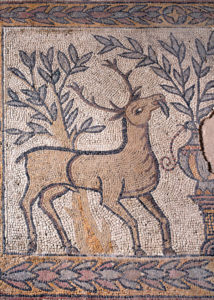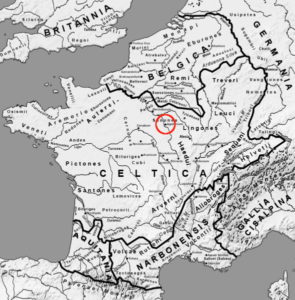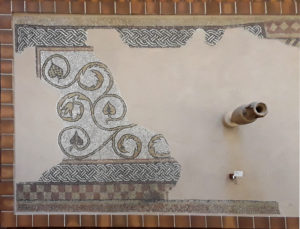Two impressive rooms showcase Roman mosaics in the Musee de Sens.
- The large archaeological room
- The underground room
The large archaeological room
The Phaeton Mosaic, discovered in 1910 in the rue du Général Dubois in Sens, is presented in several pieces :
- The centerpiece describing the fall of Phaeton
- A large rosace medallion
- Other smaller parts of the same mosaic
When it was discovered the mosaic was in poor condition. It had been seriously damaged by fiery fire in several places, and lifted up in other places by subterranean moisture.

The whole floor measured 11.10 m x 9.05 m (36 x 30′). It was framed by a border of ivy, interspersed with colorful flowers laid against a white marble background. Wide bands divided the total area into thirty-five square medallions. Because it was too big and too damaged, it was decided to only display its most impressive parts :
- Phaeton medallion
- One very well preserved geometric medallion
- Parts of the beautiful Ivy and geometric borders
Difficult choices have to be made by Museums, the most flamboyant parts of mosaics are generally displayed, while other parts, which would be quite interesting to study, are buried in vaults and only open to professionals on special request, or simply forgotten.
The Phaeton Medallion
The center of the mosaic is a large medallion, measuring 1,69 m (67″) in diameter. It was also damaged by the fire, but we can recognize four horses accompanied by a rider.

The Myth behind the mosaic :
Phaëton, son of Clymene and the solar god Helios one day went to his Father’s palace to borrow his chariot. His Father tried to dissuade him, but despite his warnings the boy got on the chariot and took the reins. It was a disaster: unable to control the horses, Phaeton drove the chariot too close to the earth and burned it, then stepping too far away, froze it. Finally, to end the catastrophe, Zeus struck Phaethon with one of his lightning bolts, killing him instantly and Helios stopped the mad race of the horses. (It is this part of the myth that is depicted on the mosaic)

The Seasons
As in many other mosaics, the heads of the Seasons are placed at the four corners around Phaeton’s medallion. They stand out against a white rounded background. While Spring is missing, Summer is crowned with golden ears of wheat and bay leaves.

Fall, dressed in a tunic wears a crown of grapes and vine, symbols of late harvests.

On the left appears Winter looking miserably cold, dressed in a white hooded cloak, his head hidden under a veil which hardly protects him from the snow !

The delicacy and variety of materials used by the mosaicist are worthy of attention. The minute tesserae of marble or glass, carefully cut and adjusted, are close to the best opus vermiculatum found in the House of the Faun of Pompeii.
The decorative medallions
Only one of the decorative medallions was left intact by the fire. It is located to the lower left of the centerpiece and is now displayed on the wall close to the staircase leading to the balcony of the room.

Other parts of the mosaic are on display on the floor of the great archaeological room.

You can admire some borders from a balcony above the room. One of them features some very elegant Ivy leaves spirals

The underground room of the Musee de Sens
You will walk through many beautiful subterranean hallways and rooms of the Musee de Sens labyrinthine sub-floor and admire there many surprising Roman remains before you enter the big underground room
Two mosaics are displayed in this impressive room :
- Mosaic of the Deer
- Mosaic of Cours Tarbe
The Deer mosaic
This is by far the more important of the two pieces. Discovered in 1876, at a depth of 1.60 m, the piece displayed on the floor is 6.75 x 5.45 m, but the original mosaic was bigger and its actual size remains unknown. The mosaicists used of marbles, limestone and terracotta tesserae. Its theme of deer facing each other on either side of a vase is early Christian and it is dated late 5th, early 6th century.

In the center of the mosaic a vase containing two leafy branches sits on a column. On either side two deer, facing each other come to eat the leaves. Behind each deer stands a tree. Due to the significant missing parts, we can’t say whether the central panel was originally in the middle of the composition and whether the borders and field framed it in a perfectly symmetrical fashion. Therefore the original dimensions of this mosaic are unknown.
A Christian theme
The theme of deer facing each other on either side of a vase is Christian. God being both the water which quenches and the food which strengthens…

… The deer represent the soul thirsty for God, of the faithful aspiring to Baptism.
Such symbolism frequent in the 5th and 6th century was particularly suitable for the decoration of a baptistery. However, because we don’t know anything about the context of this mosaic, we are unable to assume the function (religious or not?) of the building it belonged to.
The Mosaic of Cours Tarbe
During works carried out in 1976, imposing remains of buildings were found testifying to the reconstruction of the city in the 3rd century. Many walls delimited rooms with more or less well preserved floors. Four rooms were decorated with black and white geometric mosaics.

This fragment is exhibited on a wall of the great underground room.
Directions to Sens:
Sens is a commune in the Yonne department in Bourgogne-Franche-Comté 120 km from Paris. You can drive there in less than 2 hours or ride the train from Paris Bercy in an hour.


The Musee de Sens is located downtown at 135 rue des Déportés et de la Résistance, 89100 Sens. Tél. 03 86 64 46 22. Website : Musees de Sens
Like most but not all French Museum it is closed on Tuesdays.
In October 2021 I took a 2 weeks mosaic trip in Central and Southern France. I outline this trip in my article October mosaic trip, I will keep posting about the individual sites and mosaics I visited.











